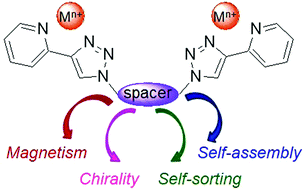Systematic study of the synthesis and coordination of 2-(1,2,3-triazol-4-yl)-pyridine to Fe(ii), Ni(ii) and Zn(ii); ion-induced folding into helicates, mesocates and larger architectures, and application to magnetism and self-selection†
Abstract
With its facile synthesis, the pyridine–1,2,3-triazole chelate is an attractive building block for coordination-driven self-assembly. When two such chelates are bridged by a spacer and exposed to cations of octahedral geometrical preference, they generally self-assemble into dinuclear triple-stranded structures in the solid state and in solution in the presence of non-coordinating counter-ions. In solution, a wider range of architectures may nevertheless form, depending on the nature of the spacer. A systematic study of the spacer and substitution pattern is therefore presented, which allows assessing the various factors affecting self-assembly around the pyridine–1,2,3-triazole chelate, as well as the stereochemical control in these architectures. Applications to chirality, magnetism and system selection are discussed, and involve Fe(II), Ni(II), Zn(II) and Cu(I) cations.


 Please wait while we load your content...
Please wait while we load your content...